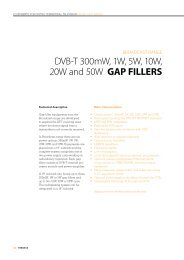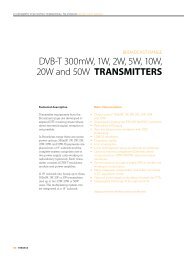You also want an ePaper? Increase the reach of your titles
YUMPU automatically turns print PDFs into web optimized ePapers that Google loves.
DAE<br />
DIGITAL ADAPTIVE<br />
EQUALIZER<br />
Technical description<br />
Gap <strong>fillers</strong> can optionally incorporate<br />
a digital adaptive equalizer<br />
(DAE) or echo canceller to get a<br />
better response in single frequency<br />
network (SFN) configurations when<br />
there is not full isolation between<br />
transmission and reception<br />
antennas.<br />
As general rule, it can be stated<br />
that a <strong>gap</strong> filler without echo canceller<br />
can be installed in a SFN (using<br />
the same input and output channel)<br />
but needs an echo signal level 10dB<br />
lower than main one (Gain Range=<br />
+10dB).<br />
However, a TRedess <strong>gap</strong> filler with<br />
DAE can be installed in locations<br />
where the antenna isolation is up<br />
to 15dB lower than the gain of the<br />
<strong>gap</strong> filler (Gain Range= -15dB). The<br />
DAE will adapt output power signal<br />
when the gain range is between<br />
-15dB and -23dB, fixing it to -12dB.<br />
Gap filler’s impulse response with an input<br />
echo 10dB higher than main signal.<br />
As well as cancelling the echo<br />
generated by antenna coupling,<br />
the DAE is able to cancel any echo<br />
from the input signal delayed up to<br />
8 seconds.<br />
In conclusion, the DAE in a TRedess<br />
<strong>gap</strong> filler allows correcting<br />
distortions of the input signal when<br />
they are generated by multipath<br />
propagation (signals inside the<br />
cancellation window).<br />
TV BROADCASTING I 23





